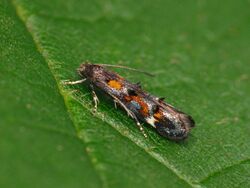Biology:Mompha raschkiella
This article may be expanded with text translated from the corresponding article in Deutsch. (January 2021) Click [show] for important translation instructions.
|
| Mompha raschkiella | |
|---|---|

| |
| Scientific classification | |
| Domain: | Eukaryota |
| Kingdom: | Animalia |
| Phylum: | Arthropoda |
| Class: | Insecta |
| Order: | Lepidoptera |
| Family: | Momphidae |
| Genus: | Mompha |
| Species: | M. raschkiella
|
| Binomial name | |
| Mompha raschkiella (Zeller, 1838) [1]
| |
| Synonyms | |
| |
Mompha raschkiella is a species of micromoth in the family Momphidae. The moth was first described by German entomologist Philipp Christoph Zeller in 1838.
Description
The wingspan is 7–11 millimetres (0.3–0.4 in). Adults are on wing in May and again in August. There are two generations per year. The moth is small and distinctively marked. The species could be confused with Mompha locupletella, but it lacks that species contrasting dark and light patches at the base of the forewing.[2]
Larvae
The oval eggs are laid on the surface of leaves, usually near the midrib. Larvae are yellow with a brown head and have a thoracic plate and an anal plate. They mine the leaves of rosebay willowherb (Epilobium angustifolium) causing a yellowish blotch on the leaves that bleach rapidly after the larvae leave them. The caterpillars occur in May to late July and late August to September They overwinter as a pupa and pupation occurs among detritus on the ground.[3][4]
Habitat
The species is endemic to Europe. They can be found in waste ground, woodland clearings, heathland, and roadside verges.[5] The moth is rare in Belgium.[4] The moth is common and widely distributed on the Isle of Wight and in southern Hampshire.[2] They can be found in the woods of Northwich.[6] The moth is common in Suffolk, especially in coastal areas and Brecks.[5][|permanent dead link|dead link}}] The species has been recorded by the St. Helens Wilflife Recording Group as scarce in St. Helens, Merseyside.[7] As of October 2009, the moth has been recorded in 9.6% of Huntingdonshire.[8]
References
- ↑ "Mompha (Psacaphora) raschkiella (Zeller, 1839)". https://fauna-eu.org/cdm_dataportal/taxon/db11fe45-e215-46db-af17-82c8d9d70ce9. Retrieved 8 May 2020.
- ↑ 2.0 2.1 "0883 Mompha raschkiella (Zeller, 1839)". Hants Moths. http://www.hantsmoths.org.uk/species/0883.php. Retrieved 8 May 2020.
- ↑ Ellis, W N. "Mompha raschkiella (Zeller, 1839) little mompha". https://bladmineerders.nl/parasites/animalia/arthropoda/insecta/lepidoptera/ditrysia/gelechioidea/momphidae/mompha/mompha-raschkiella/. Retrieved 8 May 2020.
- ↑ 4.0 4.1 "Mompha raschkiella (Zeller, 1839)". Catalogue of the Lepidoptera of Belgium. http://webh01.ua.ac.be/vve/Checklists/Lepidoptera/Momphidae/Mraschkiella.htm. Retrieved May 31, 2010.
- ↑ 5.0 5.1 "883 Mompha raschkiella, (Zeller, 1839)". Suffolk Moths. http://www.suffolkmoths.org.uk/cgi-bin/mos/account.cgi?code=0883. Retrieved May 31, 2010.
- ↑ "Micro-Moths". Norwich Woodlands. http://www.northwichwoodlands.org.uk/wildlife/micromoth.shtml. Retrieved 8 May 2020.
- ↑ "Micro Moths in St Helens". St. Helens Wilflife Recording Group. http://www.sthelenswildlife.pwp.blueyonder.co.uk/mothsmicro.htm. Retrieved May 31, 2010.
- ↑ "883 Mompha raschkiella, (Zeller, 1838)". Huntingdonshire Moth & Butterfly Group. http://www.hmbg.org/index.php?pageid=138&bf=0883&nojs=1. Retrieved May 31, 2010.
Wikidata ☰ Q148496 entry
 |


